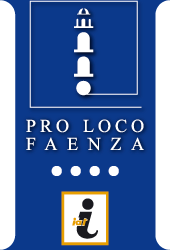- Visit Faenza
Places to see
- Accommodations
- Food and drink
- Events
- Guided tours
- News
- Ceramics
- Pro Loco Faenza
Useful infos
- City map
- City history
- Churches, monuments
- Museums
- Parks and gardens
- Essential informations for major monuments
- Routes
- Book a guided tour of the city
- Romagna Visit Card
- Palio of Niballo and Rioni
- Cultural activities
- Leisure
- Historical shops
- Twin towns
- Getting here
- How to move in the city
- Useful phone numbers
- Other useful informations
- Links

This is the most important point of the city as it is the headquarters of political and administrative power and its symbolic meaning. The piazza is naturally of very ancient origins but began to take on the aspect that still characterises it in the 15th century with the construction of the loggia in palazzo Manfredi which began after the old city government was transformed into a lordship and when the Manfredi family moved into the Palazzo del Comune. The building was then restructured and enriched on the upper level with double lancet windows in white Istria stone (only one remains today) and a large two floor loggia with seven arches. This was the first nucleus of the loggia which was then extended in the 1700’s with the intention of making the whole side of the piazza uniform, giving it much characterised architectural definition. The whole loggia was then rebuilt in neo classical style similar to the original in 1859 by the engineer Ignazio Bosi. On the other side is palazzo del Podestà to which a two floor loggia was added at the expense of the shop owners in the piazza in 1760. The initial project was from the year before and was for the creation of only one floor, but the Council of the Elders wanted it with two floors in symmetry with the loggia opposite it of the Palazzo del Comune. This is when the idea came to transform an urban space that was still not well defined into a regular piazza architecturally articulated by loggias similar to stage curtains following a typically 1700’s concept.
This side of the loggia required works between 1872-75 due to problems of staticity and the job was given to the excellent architect-engineer of the Municipality Achille Ubaldini, who used classical shapes in imitation of those in the Palazzo del Comune, which had been restructured around fifteen years earlier by Bosi. Ubaldini, who normally escaped from the neo classical canons to pursue a more eclectic culture, in this case tried to bring the new loggia in harmony with the already existing one, adapting one to the other in order to not introduce contradictory elements in the most “delicate” area of the city and full of meaning.
Other images on fotofaenza.it
- Address
Piazza del Popolo
48018 Faenza RA - Area: Center
- Map:
Graphics - HTML: Caterweb
Developed by: CicoNET
CMS: Web Portal Now
All CREDITS












